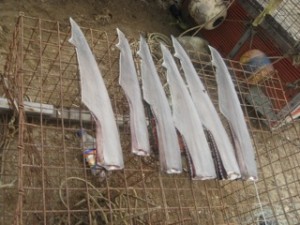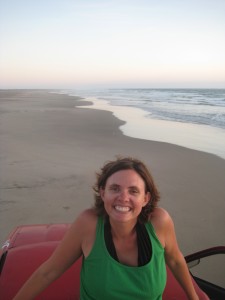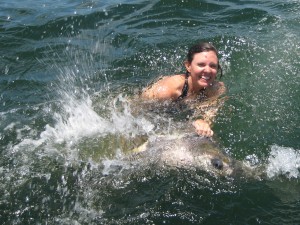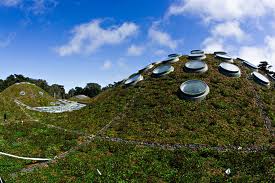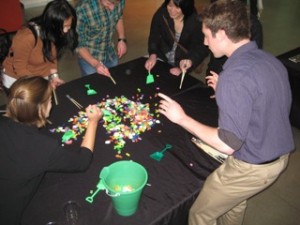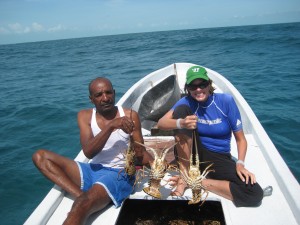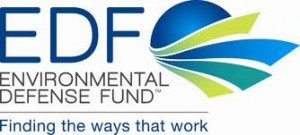This is the first in a series of three blog posts about a two-week field experience I had with a local NGO, Grupo Tortuguero, in Baja California, Mexico this summer.
It stinks in the field station this morning. I stepped outside onto the street and it smells like dead fish out there too. Someone explained that the smell is from the tuna cannery down the street. Some days, too many fish are brought to the cannery than they can process. The solution: burn them down into fishmeal, which can be sold as an organic fertilizer.
A definition of bycatch: the unintentional catch of living organisms by fishing gear.
The work I do frequently includes considerations to deal with bycatch. I’ve read a lot of reports and seen numerous upsetting pictures of fish, birds and turtles entangled in nets. I brainstorm ways to assign fishing rights that encourage responsible fishing and methods to utilize fishermen as monitors of their own actions.
I care about these animals and the ecosystems they inhabit, but a caring based on something unseen is different than the care we have for something seen and experienced ourselves. No picture, video or report prepared me to experience instances of bycatch with my own eyes. My field experience in Baja California Sur was not designed to showcase instances of bycatch, however it did just that. The idea was for me learn about Grupo Tortuguero’s work in the community of Lopez Mateos (more on that later).
Sure, I already knew that:
Worldwide, experts believe that fisheries bycatch is in the range of 27,000,000 metric tons.
24,000,0000 to 45,000,000 red snapper are caught as bycatch in Gulf of Mexico shrimp fisheries each year.
Researchers believe that between 1990 and 2008, 2.8 million sea turtles were trapped in nets as bycatch. (Six out of the seven species of sea turtles worldwide listed as vulnerable, endangered or critically endangered.)
It’s a shame to smell wasted tuna from the cannery. Another bycatch experience happened a few days ago. We were out on a turtle rodeo (definitely more on that later!) when we came across a ghost net. Ghost nets are simply lost or deserted nets that continue to capture and kill marine species. Our boat was tasked with pulling the net out of the ocean. Yards and yards of abandoned net were pulled out of the water with dozens of fish in various stages of decomposition caught in it. Large tuna, barracuda and snapper were pulled out of the net and tossed overboard along with lots of small fish and crabs I could not identify. The smell of the decomposing fish made even our experienced fisherman captain ill. A net left alone in the ocean always runs the risk of becoming untied from an anchor and being lost to unnecessarily capture marine animals.
Nets don’t have to be lost to cause harm. Yesterday I went out with a couple of fishermen to bring in three nets they’d left overnight. On the way out of the harbor I inquired about the type of fish we planned to fish. Flounder, they told me. Thirty minutes into constantly pulling a net into the boat, we encountered our first flounder. Until that point, they had been yanking dead rays, juvenile tuna, crabs and other fish out of the net. Over four hours with just three huge nets, I would guess that 80% of the animals were thrown to the very well-fed group of pelicans that hung out by our boat. 80% bycatch! Other fish were kept on board for consumption by the fishermen or to sell for a price much less than they get for flounder
.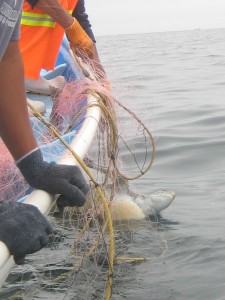
While the fishermen were approaching the end of the second net I heard one of them say, “there’s something big here… what is it?” Then I saw “it” emerge out of the water: a juvenile green turtle—deeply tangled in the deadly net. Its eyes were closed, neck limp. It had died. In the net. That they left out last night. Nothing could have prepared me for that moment. I choked back a couple of tears, closed my eyes and looked away from the turtle for a while. Then I snapped a picture because to do the work that I do, I don’t ever want to forget that moment. Later that day I recounted the story and my emotional response to Juan, one of Grupo Tortuguero’s biologists. Juan replied kindly and simply: “that’s why I do what I do.” Me too, Juan.
This community, along with thousands of others in the world depends on fishing for their livelihood. The fishermen are good people that are doing a job they’ve done for decades. It’s time to help them do it better. An 80% fish bycatch plus dead turtles for a few pounds of flounder is not acceptable. We need to help fishermen find better ways to fish. In the meantime, we can support sustainably caught fish and organizations like Grupo Tortuguero and EDF that work on small-scale fisheries.

